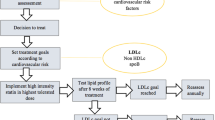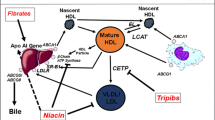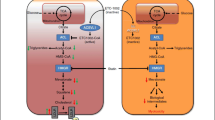Abstract
Recent trials have emphasized that more intensive low-density lipoprotein cholesterol (LDL-C) lowering results in a further reduction in cardiovascular disease risk. Uptitration of statins has limited incremental LDLC-lowering effects and leads to an increased incidence of side effects. Therefore, attention has shifted toward alternative LDL-C-lowering modalities. Several promising compounds have entered the clinical trial arena, although with mixed results. Acyl-coenzyme A: cholesterol O-acyltransferase (ACAT) inhibitors failed to show benefit. Microsomal triglyceride transfer protein and squalene synthase inhibitors, in spite of beneficial lipid profile changes, have shown adverse event profiles. In contrast, inhibitors of intestinal cholesterol absorption have shown LDL-C-lowering efficacy associated with few side effects. The inhibition of apolipoprotein B100 synthesis by antisense oligonucleotides has now been tested in phase 2 clinical trials, with promising results. Finally, compounds modifying protein convertase subtilisin/kexin type 9 levels are currently in the preclinical phase. In the present article, we discuss these LDLC-lowering strategies.
Similar content being viewed by others
References and Recommended Reading
National Cholesterol Education Program (NCEP) Expert Panel on Detection, Evaluation, and Treatment of High Blood Cholesterol in Adults (Adult Treatment III): Third report of the National Cholesterol Education Program (NCEP) Expert Panel on Detection, Evaluation, and Treatment of High Blood Cholesterol in Adults (Adult Treatment III) final report. Circulation 2002, 106:3143–3421.
Brown MS, Goldstein JL: A receptor-mediated pathway for cholesterol homeostasis. Science 1986, 232:34–47.
Goldstein JL, Brown MS: Regulation of the mevalonate pathway. Nature 1990, 343:425–430.
Tavridou A, Kaklamanis L, Megaritis G, et al.: Pharmacological characterization in vitro of EP2306 and EP2302, potent inhibitors of squalene synthase and lipid biosynthesis. Eur J Pharmacol 2006, 535:34–42.
Bliznakov EG: Lipid-lowering drugs (statins), cholesterol, and coenzyme Q10. The Baycol case—a modern Pandora’s box. Biomed Pharmacother 2002, 56:56–59.
Amano Y, Nishimoto T, Tozawa R, et al.: Lipid-lowering effects of TAK-475, a squalene synthase inhibitor, in animal models of familial hypercholesterolemia. Eur J Pharmacol 2003, 466:155–161.
Nishimoto T, Amano Y, Tozawa R, et al.: Lipid-lowering properties of TAK-475, a squalene synthase inhibitor, in vivo and in vitro. Br J Pharmacol 2003, 139:911–918.
Nishimoto T, Tozawa R, Amano Y, et al.: Comparing myotoxic effects of squalene synthase inhibitor, T-91485, and 3-hydroxy-3-methylglutaryl coenzyme A (HMG-CoA) reductase inhibitors in human myocytes. Biochem Pharmacol 2003, 66:2133–2139.
Piper E, Price G, Chen Y: TAK-475, a squalene synthase inhibitor, improves lipid profile in hyperlipidemic subjects [abstract 1493]. Circulation 2006, 114:II288.
Perez A, Kupfer S, Chen Y: TAK-475 to atorvastatin provides incremental lipid benefits [abstract 675]. Circulation 2006, 114:II113–II114.
Nishimoto T, Ishikawa E, Anayama H, et al.: Protective effects of a squalene synthase inhibitor, lapaquistat acetate (TAK-475), on statin-induced myotoxicity in guinea pigs. Toxicol Appl Pharmacol 2007, 223:39–45.
Takeda Pharmaceutical Company Limited: Discontinuation of Development of TAK-475 A Compound for Treatment of Hypercholesterolemia. Available at http://www.takeda.com/press/article_29153.html. Accessed July 30, 2008.
Altmann SW, Davis HR Jr, Zhu LJ, et al.: Niemann-pick C1 like 1 protein is critical for intestinal cholesterol absorption. Science 2004, 303:1201–1204.
Lewis MC, Brieaddy LE, Root C: Effects of 2164U90 on ileal bile acid absorption and serum cholesterol in rats and mice. J Lipid Res 1995, 36:1098–1105.
Ichihashi T, Izawa M, Miyata K, et al.: Mechanism of hypocholesterolemic action of S-8921 in rats: S-8921 inhibits ileal bile acid absorption. J Pharmacol Exp Ther 1998, 284:43–50.
Huff MW, Telford DE, Edwards JY, et al.: Inhibition of the apical sodium-dependent bile acid transporter reduces LDL cholesterol and ApoB by enhanced plasma clearance of LDL ApoB. Arterioscler Thromb Vasc Biol 2002, 22:1884–1891.
Kitayama K, Nakai D, Kono K, et al.: Novel non-systemic inhibitor of ileal apical Na+-dependent bile acid transporter reduces serum cholesterol levels in hamsters and monkeys. Eur J Pharmacol 2006, 539:89–98.
Bhat BG, Rapp SR, Beaudry JA, et al.: Inhibition of ileal bile acid transport and reduced atherosclerosis in apoE-/- mice by SC-435. J Lipid Res 2003, 44:1614–1621.
Li H, Xu G, Shang Q, et al.: Inhibition of ileal bile acid transport lowers plasma cholesterol levels by inactivating hepatic farnesoid X receptor and stimulating cholesterol 7 [alpha]-hydroxylase. Metabolism 2004, 53:927–932.
West KL, Zern TL, Butteiger DN, et al.: SC-435, an ileal apical sodium co-dependent bile acid transporter (ASBT) inhibitor lowers plasma cholesterol and reduces atherosclerosis in guinea pigs. Atherosclerosis 2003, 171:201–210.
Telford DE, Edwards JY, Lipson SM, et al.: Inhibition of both the apical sodium-dependent bile acid transporter and HMG-CoA reductase markedly enhances the clearance of LDL apoB. J Lipid Res 2003, 44:943–952.
Davidson MH, Dillon MA, Gordon B, et al.: Colesevelam hydrochloride (cholestagel): a new, potent bile acid sequestrant associated with a low incidence of gastrointestinal side effects. Arch Intern Med 1999, 159:1893–1900.
Devaraj S, Autret B, Jialal I: Effects of colesevelam hydrochloride (WelChol) on biomarkers of inflammation in patients with mild hypercholesterolemia. Am J Cardiol 2006, 98:641–643.
Insull W Jr, Toth P, Mullican W, et al.: Effectiveness of colesevelam hydrochloride in decreasing LDL cholesterol in patients with primary hypercholesterolemia: a 24- week randomized controlled trial. Mayo Clin Proc 2001, 76:971–982.
Hunninghake D, Insull W, Toth P, et al.: Coadministration of colesevelam hydrochloride with atorvastatin lowers LDL cholesterol additively. Atherosclerosis 2001, 158:407–416.
Knapp HH, Schrott H, Ma P, et al.: Efficacy and safety of combination simvastatin and colesevelam in patients with primary hypercholesterolemia. Am J Med 2001, 110:352–360.
Miettinen TA, Puska P, Gylling H, et al.: Reduction of serum cholesterol with sitostanol-ester margarine in a mildly hypercholesterolemic population. N Engl J Med 1995, 333:1308–1312.
Blair SN, Capuzzi DM, Gottlieb SO, et al.: Incremental reduction of serum total cholesterol and low-density lipoprotein cholesterol with the addition of plant stanol ester-containing spread to statin therapy. Am J Cardiol 2000, 86:46–52.
Burnett JR: FM-VP4 Forbes Medi-Tech. Curr Opin Investig Drugs 2003, 4:1120–1125.
Ebine N, Jia X, Demonty I, et al.: Effects of a water-soluble phytostanol ester on plasma cholesterol levels and red blood cell fragility in hamsters. Lipids 2005, 40:175–180.
Lukic T, Wasan KM, Zamfir D, et al.: Disodium ascorbyl phytostanyl phosphate reduces plasma cholesterol concentrations and atherosclerotic lesion formation in apolipoprotein E-deficient mice. Metabolism 2003, 52:425–431.
Vissers MN, Trip MD, Pritchard PH, et al.: Efficacy and safety of disodium ascorbyl phytostanol phosphates in men with moderate dyslipidemia. Eur J Clin Pharmacol 2008, 64:651–661.
Dujovne CA, Ettinger MP, McNeer JF, et al.: Efficacy and safety of a potent new selective cholesterol absorption inhibitor, ezetimibe, in patients with primary hypercholesterolemia. Am J Cardiol 2002, 90:1092–1097.
Knopp RH, Gitter H, Truitt T, et al.: Effects of ezetimibe, a new cholesterol absorption inhibitor, on plasma lipids in patients with primary hypercholesterolemia. Eur Heart J 2003, 24:729–741.
Knopp RH, Dujovne CA, Le BA, et al.: Evaluation of the efficacy, safety, and tolerability of ezetimibe in primary hypercholesterolaemia: a pooled analysis from two controlled phase III clinical studies. Int J Clin Pract 2003, 57:363–368.
Ballantyne CM, Houri J, Notarbartolo A, et al.: Effect of ezetimibe coadministered with atorvastatin in 628 patients with primary hypercholesterolemia: a prospective, randomized, double-blind trial. Circulation 2003, 107:2409–2415.
Davidson MH, McGarry T, Bettis R, et al.: Ezetimibe coadministered with simvastatin in patients with primary hypercholesterolemia. J Am Coll Cardiol 2002, 40:2125–2134.
Pearson TA, Denke MA, McBride PE, et al.: A community-based, randomized trial of ezetimibe added to statin therapy to attain NCEP ATP III goals for LDL cholesterol in hypercholesterolemic patients: the ezetimibe add-on to statin for effectiveness (EASE) trial. Mayo Clin Proc 2005, 80:587–595.
Pearson TA, Denke MA, McBride PE, et al.: Effectiveness of ezetimibe added to ongoing statin therapy in modifying lipid profiles and low-density lipoprotein cholesterol goal attainment in patients of different races and ethnicities: a substudy of the Ezetimibe add-on to statin for effectiveness trial. Mayo Clin Proc 2006, 81:1177–1185.
Kastelein JJ, Akdim F, Stroes ES, et al.: Simvastatin with or without ezetimibe in familial hypercholesterolemia. N Engl J Med 2008, 358:1431–1443.
Asami Y, Yamagishi I, Akiyoshi K, et al.: Inhibitory effect of TS-962 on the formation of early atherosclerotic lesions in high fat-fed hyperlipidemic hamsters. Atherosclerosis 1999, 146:237–242.
Chiwata T, Aragane K, Fujinami K, et al.: Direct effect of an acyl-CoA:cholesterol acyltransferase inhibitor, F-1394, on atherosclerosis in apolipoprotein E and low density lipoprotein receptor double knockout mice. Br J Pharmacol 2001, 133:1005–1012.
Nicolosi RJ, Wilson TA, Krause BR: The ACAT inhibitor, CI-1011 is effective in the prevention and regression of aortic fatty streak area in hamsters. Atherosclerosis 1998, 137:77–85.
Tardif JC, Gregoire J, L’Allier PL, et al.: Effects of the acyl coenzyme A:cholesterol acyltransferase inhibitor avasimibe on human atherosclerotic lesions. Circulation 2004, 110:3372–3377.
Nissen SE, Tuzcu EM, Brewer HB, et al.: Effect of ACAT inhibition on the progression of coronary atherosclerosis. N Engl J Med 2006, 354:1253–1263.
Buhman KK, Accad M, Novak S, et al.: Resistance to dietinduced hypercholesterolemia and gallstone formation in ACAT2-deficient mice. Nat Med 2000, 6:1341–1347.
Repa JJ, Buhman KK, Farese RV Jr, et al.: ACAT2 deficiency limits cholesterol absorption in the cholesterolfed mouse: impact on hepatic cholesterol homeostasis. Hepatology 2004, 40:1088–1097.
Willner EL, Tow B, Buhman KK, et al.: Deficiency of acyl CoA:cholesterol acyltransferase 2 prevents atherosclerosis in apolipoprotein E-deficient mice. Proc Natl Acad Sci U S A 2003, 100:1262–1267.
Bell TA III, Brown JM, Graham MJ, et al.: Liver-specific inhibition of acyl-coenzyme A:cholesterol acyltransferase 2 with antisense oligonucleotides limits atherosclerosis development in apolipoprotein B100-only low-density lipoprotein receptor-/- mice. Arterioscler Thromb Vasc Biol 2006, 26:1814–1820.
Sankatsing RR, Fouchier SW, de Haan S, et al.: Hepatic and cardiovascular consequences of familial hypobetalipoproteinemia. Arterioscler Thromb Vasc Biol 2005, 25:1979–1984.
Ueshima K, Kihisa-Umeno H, Nagayoshi A, et al.: Implitapide, a microsomal triglyceride transfer protein inhibitor, reduces progression of atherosclerosis in apolipoprotein E knockout mice fed a Western-type diet: involvement of the inhibition of postprandial triglyceride elevation. Biol Pharm Bull 2005, 28:247–252.
Zaiss S, Gruetzmann R, Mueller U: Bay 13-9952, an inhibitor of the microsomal triglyceride transfer protein (MTP), inhibits atherosclerotic plaque formation in cholesterol-fed rabbits in spite of a concomitant reduction of vitamin E. Circulation 1999, 100(Suppl 1):1341.
Stein EA, Isaacsohn J, Mazzu A, Ziegler R: Effect of Bay 13-9952, a microsomal triglyceride transfer protein inhibitor on lipids and lipoproteins in dyslipoproteinemic patients. Circulation 1999, 100(Suppl 1):1342.
Stein EA, Ames SA, Moore LJ, et al.: Inhibition of postprandial fat absorption with the MTP inhibitor BAY 13-9952. Circulation 2000, 102(Suppl 2):2913.
Chandler CE, Wilder DE, Pettini JL, et al.: CP-346086: an MTP inhibitor that lowers plasma cholesterol and triglycerides in experimental animals and in humans. J Lipid Res 2003, 44:1887–1901.
Cuchel M, Bloedon LT, Szapary PO, et al.: Inhibition of microsomal triglyceride transfer protein in familial hypercholesterolemia. N Engl J Med 2007, 356:148–156.
Aggarwal D, West KL, Zern TL, et al.: JTT-130, a microsomal triglyceride transfer protein (MTP) inhibitor lowers plasma triglycerides and LDL cholesterol concentrations without increasing hepatic triglycerides in guinea pigs. BMC Cardiovasc Disord 2005, 5:30.
Surface Logix: Surface logix achieves objectives with SLx-4090 in phase 2a clinical trial. Available at http://www.surfacelogix.com/news/news_080129.htm. Accessed July 30, 2008.
Ito MK: ISIS 301012 gene therapy for hypercholesterolemia: sense, antisense, or nonsense? Ann Pharmacother 2007, 41:1669–1678.
Schonfeld G, Lin X, Yue P: Familial hypobetalipoproteinemia: genetics and metabolism. Cell Mol Life Sci 2005, 62:1372–1378.
Crooke RM, Graham MJ, Lemonidis KM, et al.: An apolipoprotein B antisense oligonucleotide lowers LDL cholesterol in hyperlipidemic mice without causing hepatic steatosis. J Lipid Res 2005, 46:872–884.
Chuang E, Lemonidis KM, Whipple C, et al.: A human apolipoprotein B antisense inhibitor reduces aortic sinus plaque volume in LDL receptor deficient mice expressing a human ApoB-100 transgene. Atheroscler Suppl 2006, 7:466.
Kastelein JJ, Wedel MK, Baker BF, et al.: Potent reduction of apolipoprotein B and low-density lipoprotein cholesterol by short-term administration of an antisense inhibitor of apolipoprotein B. Circulation 2006, 114:1729–1735.
Akdim F, Stroes ES, Kastelein JJ: Antisense apolipoprotein B therapy: where do we stand? Curr Opin Lipidol 2007, 18:397–400.
Isis Pharmaceuticals: Isis Pharmaceuticals reports ISIS 301012 significantly reduces all atherogenic lipids when dosed as a single agent and when coadministered with statins [press release]. November 12, 2006. Available at http://ir.isispharm.com/releasedetail.cfm?ReleaseID=220203. Accessed July 30, 2008.
Isis Pharmaceuticals: New data presented at the ACC show ISIS 301012 monotherapy reduces apoB to undetectable levels and reduces LDL-C 70% [press release]. March 25, 2007. Available at http://files.shareholder.com/downloads/ISIS/372001136x0x87214/b62c7770-6c91-4039-a826-c0f574ef000c/ISIS0326.pdf. Accessed July 30, 2008.
ClinicalTrials.gov: Measure Liver Fat Content After ISIS 301012 Administration. Available at http://clinicaltrials.gov/ct2/show/NCT00362180?term=isis301012»nk=7. Accessed October 1, 2007.
Zimmermann TS, Lee AC, Akinc A, et al.: RNAi-mediated gene silencing in non-human primates. Nature 2006, 441:111–114.
Kotowski IK, Pertsemlidis A, Luke A, et al.: A spectrum of PCSK9 alleles contributes to plasma levels of low-density lipoprotein cholesterol. Am J Hum Genet 2006, 78:410–422.
Graham MJ, Lemonidis KM, Whipple CP, et al.: Antisense inhibition of proprotein convertase subtilisin/kexin type 9 reduces serum LDL in hyperlipidemic mice. J Lipid Res 2007, 48:763–767.
Cohen JC, Boerwinkle E, Mosley TH Jr, Hobbs HH: Sequence variations in PCSK9, low LDL, and protection against coronary heart disease. N Engl J Med 2006, 354:1264–1272.
Author information
Authors and Affiliations
Corresponding author
Rights and permissions
About this article
Cite this article
Visser, M.E., Jakulj, L., Kastelein, J.J.P. et al. LDL-C-Lowering therapy: Current and future therapeutic targets. Curr Cardiol Rep 10, 512–520 (2008). https://doi.org/10.1007/s11886-008-0080-7
Published:
Issue Date:
DOI: https://doi.org/10.1007/s11886-008-0080-7




